Part 5: Interventions
OHCP Assessment – Interventions
- Check any of the interventions listed below that you feel are needed for the older person. This simple treatment tool can help you choose appropriate interventions based on a person's oral health.
- Therapeutic dental products, such as the examples to be discussed in this training module, should be used in conjunction with recommendations from a dental professional, and will treat oral diseases and conditions.
- Cosmetic products, such as alcohol-based mouth rinses, can be damaging to oral tissues, especially for people with dry mouth, and generally do not treat oral diseases and conditions.
|
Interventions for oral hygiene care |
|---|
| ___ use mouthswab |
| ___ use electric toothbrush |
| ___ use suction toothbrush |
| ___ use regular toothbrush |
| ___ use toothbrush backward bent/2 toothbrushes |
| ___ use interproximal toothbrush or floss |
| ___ use regular fluoride toothpaste morning/night |
| ___ scrub denture(s) with soap and water morning/night |
| ___ soak denture(s) at night in water/denture tablet |
| ___ use saliva substitute for dry mouth |
| ___ use fluoride varnish or other fluoride products |
| ___ use chlorhexidine mouthrinse (as prescribed by a dentist or medical director) |
| ___ other __________________ |
Mouthswabs, Toothbrushes, and Floss
|
OHCP Interventions |
||
|---|---|---|
|
Mouthswabs, Electric Toothbrushes, and Suction Toothbrushes
|
||
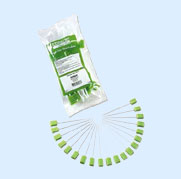
|

|
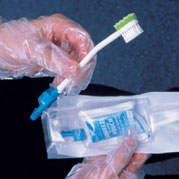
|
|
Regular Toothbrushes, Interproximal Toothbrushes, and Floss
|
||
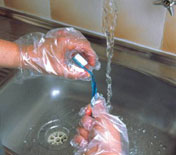
|
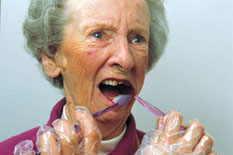
|
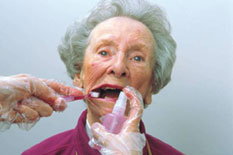
|
Fluoride Products
| Introduction to Fluoride | ||
|---|---|---|
|
In older adults, tooth decay can occur on tooth crowns, tooth roots, and around existing fillings. Various sources of fluoride can be used to help prevent tooth decay and to remineralize and minimize any existing decay. Fluoride is also helpful to strengthen eroded, abraded or exposed root surfaces. Fluoride is most beneficial because of its topical effects directly onto the tooth surface. Fluoride's systemic effects play a lesser role. This means that fluoride is most effective when teeth have fluoride applied frequently. Fluoride has three modes of action in preventing tooth decay: |
||
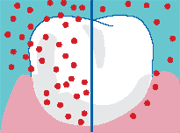
1. Reduces the formation of plaque acids |
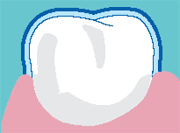
2. Helps prevent mineral loss caused by plaque acids |
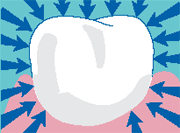
3. Promotes re-mineralization of early decay |
Practical Oral Care Booklet, 2002
A key source of fluoride is in our community water supply. Frequent consumption of fluoridated water in our drinks and food provides an excellent regular fluoride source. Another key fluoride source is fluoridated toothpastes. After brushing with toothpaste, rinse the mouth slightly, or even not at all, so that some of the toothpaste remains around the teeth for as long as possible.
For older adults with decay present or who are at higher risk for developing tooth decay (for example, people with specific medical conditions such as dementia, or taking medications that dry the mouth) additional therapeutic fluoride sources are needed. Various types of fluoride toothpastes, mouthrinses and gels are available to optimize a resident’s sources of fluoride. These therapeutic fluoride products can be purchased from the pharmacy and used at a frequency as discussed with a dental professional. Therapeutic fluorides are of several types – acidulated phosphate fluoride, stannous fluoride, and neutral sodium fluoride. Generally for older adults, neutral sodium fluoride is the product of choice, as the other fluorides may be damaging to tooth-colored fillings and crown and bridgework, and may be too harsh for people with a dry mouth.
|
Fluoride Toothpastes |
|---|
|
| Other Fluoride Products |
|---|
|
Denture Care
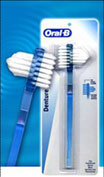
|
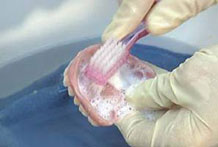
|
- Scrub dentures with a hard toothbrush or denture brush and a plain, non-perfumed soap or denture paste. Although chemical tablets, solutions, and toothpastes can be used to clean dentures, the initial step of physical cleaning with a brush, soap, and water is the key.
- While scrubbing a denture, hold it over a basin filled with water or several layers of paper towel. If the denture is dropped, it will be less likely to break.
- Dentures should be left out of the mouth for part of each 24-hour period to allow the tissues under the dentures to stay healthy. A practical time to do this is when the person is sleeping. However, some people like to wear their dentures when they sleep.
- When the denture is out of the mouth, it should be stored in a container of water. Denture tablets are a personal perference, but are not essential. Storage in water is adequate.
- Replace or clean denture containers regularly.
- Ensure that all dentures are labeled with the name of the resident to whom they belong.
Dry Mouth
- Dry mouth can be a result of direct adverse effects of many medications and medical conditions. Dry mouth can sometimes be alleviated by consulting a doctor about medications that are affecting saliva and/or by sipping water frequently.
- Saliva substitutes can be used as needed, especially before meals and at bedtime. Gels purchased from the pharmacy can be rubbed all over the teeth, gums, tongue, and dentures.
- Other helpful products include additive-free toothpastes, alcohol-free mouthwashes, and sugar-free gum and candy.
Chlorhexidine Gluconate
- If the gums are bleeding and there is abundant dental plaque present, a product containing chlorhexidine gluconate may be prescribed by the person's dentist or medical director, usually daily or three times weekly. These products help to reduce plaque and growth of microorganisms that cause dental decay and gum disease. Thus, they are useful for people at high risk for dental decay and/or gum disease. Chlorhexidine can also be used for relief of oral mucosal conditions such as recurrent aphthous ulceration or oral mucositis resulting from oral radiotherapy.
- Chlorhexidine mouthrinse does not contain alcohol, which can be harsh for people with dry mouths. It can either be rinsed around the mouth or sprayed onto the teeth and oral soft tissues using a small atomizer or spray bottle. For example, spray bottles of chlorhexidine are often useful for people with swallowing problems. Chlorhexidine gel can be brushed or swabbed onto teeth and oral soft tissues.
- Long-term use of chlorhexidine gluconate may cause a mild brown staining of the teeth, oral tissues and dentures. If chlorhexidine must be used long-term, it should be used intermittently at a frequency as discussed with a dental professional. The frequency of use of chlorhexidine mouthrinse or gel is determined by the severity and risk for oral diseases, and other factors such as a person's selfcare abilities, behavioral problems, medical conditions, swallowing problems, dietary intake, and the like.
- Chlorhexidine is safe to use as described above. More than the contents of one entire bottle of chlorhexidine 0.2% w/v mouthrinse or one entire bottle of chlorhexidine 0.2% w/v gel would have to be ingested at one point in time to cause toxicity.
Interventions for Special Needs
Treatment for Specific Oral Health Conditions
Below is a multimedia presentation that runs approximately 8 minutes. In this lecture, viewers will briefly review some of the preventative interventions discussed in this section, and also be provided additional treatment recommendations for dry mouth, denture stomatitis, candidiasis, oral mucositis, and angular cheilitis.
Palliative Oral Hygiene Care
People who are in the end stages of a terminal disease often need special oral hygiene interventions. To learn more about oral health needs at the end of life, Oral Hygiene Care for Palliative Care Residents in Nursing Homes."
OHCP Practice Quiz
Practice using the Oral Health Care Plan (OHCP) by viewing the interventions part of the form for Mrs. Rose East, who is being admitted to your nursing home.
Mrs. East has Alzheimer's disease and forgets to clean her teeth and her dentures, so she needs others to help her do this. She has a complete upper denture and a partial lower denture, which she insists on wearing day and night. Several of her bottom front teeth remain, but one of these teeth has broken off. She has a very dry mouth. She last saw a dentist on March 11 of last year, but the dentist she saw has since moved away.
|
Interventions for oral hygiene care |
|---|
| ___ use mouthswab |
| ___ use electric toothbrush |
| ___ use suction toothbrush |
| ___ use regular toothbrush |
| ___ use toothbrush backward bent/2 toothbrushes |
| ___ use interproximal toothbrush or floss |
| ___ use regular fluoride toothpaste morning/night |
| ___ scrub denture(s) with soap and water morning/night |
| ___ soak denture(s) at night in water/denture tablet |
| ___ use saliva substitute for dry mouth |
| ___ use fluoride varnish or other fluoride products |
| ___ use chlorhexidine mouthrinse (as prescribed by a dentist or medical director) |
| ___ other __________________ |
OHCP Practice Answer
|
Interventions for oral hygiene care |
|
|---|---|
| use mouthswab | No |
| use electric toothbrush | No |
| use suction toothbrush | No |
| use regular toothbrush | Yes |
| use toothbrush backward bent/2 toothbrushes | No |
| use interproximal toothbrush or floss | Yes |
| use regular fluoride toothpaste morning/night | Yes |
| scrub denture(s) with soap and water morning/night | Yes |
| soak denture(s) at night in water/denture tablet | Yes |
| use saliva substitute for dry mouth | Yes |
| use fluoride varnish or other fluoride products | No |
| use chlorhexidine mouthrinse (as prescribed by a dentist or medical director) | Yes |
| other __________________ | No |
Commentary
Mrs. East has a very dry mouth, and therefore could use a saliva substitute to replace her missing saliva. As she has experienced dental decay and dental plaque on her remaining teeth, she could use chlorhexidine used daily to reduce the bacteria that cause oral diseases. She also needs to have her dentures cleaned regularly and her teeth cleaned with a fluoride toothpaste.
Oral Hygiene Care Plan (Chalmers, 2004 for use by the Iowa Geriatric Education Center; reviewed by Marchini, 2016; Review 2023)